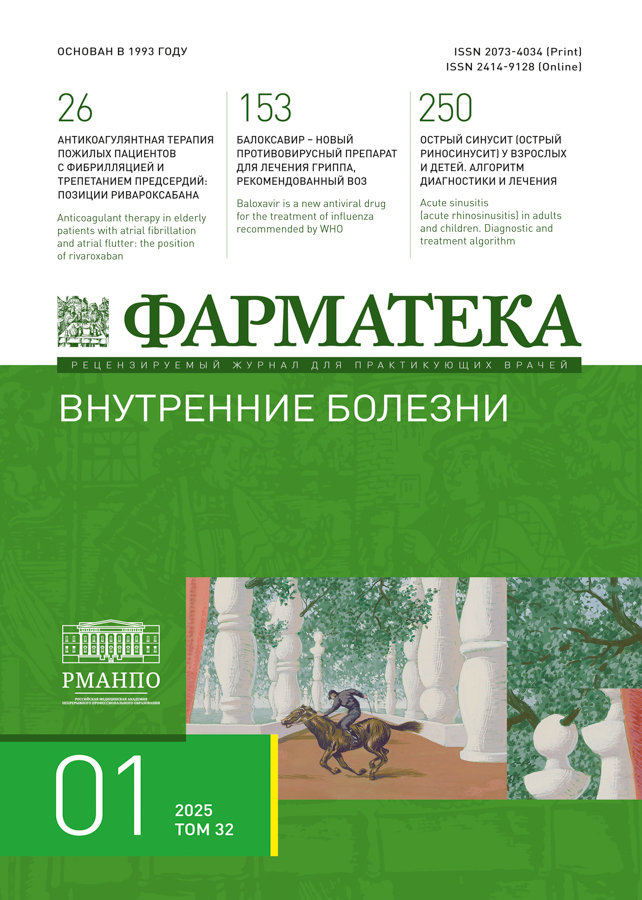Predictors of nocturnal hypoxemia in stable COPD patients
- 作者: Babak S.L.1, Gorbunova M.V.1, Malyavin A.G.1
-
隶属关系:
- Russian University of Medicine
- 期: 卷 32, 编号 1 (2025)
- 页面: 176-180
- 栏目: Pulmonology/ENT/ARVI
- ##submission.datePublished##: 20.05.2025
- URL: https://journals.eco-vector.com/2073-4034/article/view/679979
- DOI: https://doi.org/10.18565/pharmateca.2025.1.176-180
- ID: 679979
如何引用文章
详细
Background: COPD is a heterogeneous disease with multiple variant forms. As lung function declines and the disease progresses, the risk of alveolar hypoventilation with subsequent nocturnal hypoxemia increases. It is possible that nocturnal hypoxemia with tissue hypoxia plays a key role in the evolution of comorbid extrapulmonary disease. The aim of the present study was to identify predictors of nocturnal hypoxemia in stable COPD patients.
Materials and methods: A cross-sectional observational study included 106 stable COPD patients managed at a respiratory medical center (RMC) between 2019 and 2024 who completed ambulatory computerized somnography, pulmonary function testing, questionnaire and laboratory screening. Nocturnal hypoxemia (NH) was defined according to a time to saturation under 90% (T90) index >10%. Based on the absence/presence of NH, patients were classified into groups of patients with NH (NH+) and without NH (NH-). Predictors affecting nocturnal hypoxemia were identified using multivariate analysis and logistic regression models.
Results: There was a statistically significant effect of age (OR=1.06; 95% CI: [1.02–1.12]; p=0.011), COPD Assessment Test (CAT) score (OR=1.48; 95% CI: [1.10–2.00]; p=0.009), FEV1 (% predicted) (OR=0.96; 95% CI: [0.93–0.99]; p=0.015), high-density lipoprotein (HDL-C) levels (OR=1.02; 95% CI: [1.00–1.04]; p=0.034) on nocturnal hypoxemia. Multivariate regression analysis detected a statistically significant impact on nocturnal hypoxemia of such predictors as: 1) FEV1<50% (% predicted) (OR=3.46; 95% CI: [1.15–10.46]; p=0.028), increasing the risk of NH in 3.46 times; 2) insulin resistance index (HOMA-IR) >3 (OR=3.20; 95% CI: [1.09–9.35]; p=0.034), increasing the risk of NH in 3.2 times.
Conclusions: Significant predictors of nocturnal hypoxemia in stable COPD patients may be such parameters as: decrease in FEV1<50% and change in HOMA-IR index >3, increasing the risks of nocturnal hypoxemia by 3.46 and 3.2 times, respectively. This tendency should be taken into consideration in therapy of stable COPD patients.
全文:
作者简介
Sergey Babak
Russian University of Medicine
编辑信件的主要联系方式.
Email: sergbabak@mail.ru
ORCID iD: 0000-0002-6571-1220
SPIN 代码: 5213-3620
Scopus 作者 ID: 45560913500
Researcher ID: KAO-3183-2024
Dr. Sci. (Med.), Associate Professor, Pulmonologist, Professor, Department of Phthisiology and Pulmonology, Research Institute of Clinical Medicine n.a. N.A. Semashko
俄罗斯联邦, MoscowMarina Gorbunova
Russian University of Medicine
Email: mgorb@mail.ru
ORCID iD: 0000-0002-2039-0072
Scopus 作者 ID: 45561369300
Dr. Sci. (Med.), Pulmonologist, Associate Professor at the Department of Phthisiology and Pulmonology, Research and Educational Institute of Clinical Medicine named after N.A. Semashko
俄罗斯联邦, MoscowAndrey Malyavin
Russian University of Medicine
Email: maliavin@mail.ru
ORCID iD: 0000-0002-6128-5914
SPIN 代码: 8264-5394
Scopus 作者 ID: 6701876872
Dr. Sci. (Med.), Pulmonologist, Professor at the Department of Phthisiology and Pulmonology, Research and Educational Institute of Clinical Medicine named after N.A. Semashko, Chief External Expert in Pulmonology of the Ministry of Healthcare of the Russian Federation for the Central Federal District
俄罗斯联邦, Moscow参考
- Yan X., Song Y., Shen C., et al. Mucoactive and antioxidant medicines for COPD: consensus of a group of Chinese pulmonary physicians. Int J Chron Obstruct Pulmon Dis. 2017 Mar 22;12:803–812. doi: 10.2147/COPD.S114423.
- Vogelmeier C.F., Romfn-Rodriguez M., Singh D., et al. Goals of COPD treatment: Focus on symptoms and exacerbations. Respir Med. 2020 May;166:105938. doi: 10.1016/j.rmed.2020.105938.
- GBD 2017 DALYs and HALE Collaborators. Global, regional, and national disability-adjusted life-years (DALYs) for 359 diseases and injuries and healthy life expectancy (HALE) for 195 countries and territories, 1990-2017: a systematic analysis for the Global Burden of Disease Study 2017. Lancet. 2018 Nov 10;392(10159):1859–1922. doi: 10.1016/S0140-6736(18)32335-3.
- Global strategy for prevention, diagnosis and management of COPD: 2025 Report. [Electronic resource], date of access: 26.02.2025. URL: https://goldcopd.org/wp-content/uploads/2024/11/GOLD-2025-Report-v1.0-15Nov2024_WMV.pdf
- Клинические рекомендации. Хроническая обструктивная болезнь легких. 2024–2026 (17.12.2024). ID:603_3. [Электронный ресурс], дата обращения: 26.02.2025. [Clinical guidelines. Chronic obstructive pulmonary disease. 2024–2026 (12/17/2024). ID:603_3. [Electronic resource], accessed: 02/26/2025. URL: https://cr.minzdrav.gov.ru/view-cr/603_3
- Kapur V.K., Auckley D.H., Chowdhuri S. et al. Clinical Practice Guideline for Diagnostic Testing for Adult Obstructive Sleep Apnea: An American Academy of Sleep Medicine Clinical Practice Guideline. J Clin Sleep Med. 2017;13(3):479–504. (In Russ.)]. doi: 10.5664/jcsm.6506.
- Pillar G., Berall M., Berry R. et al. Detecting central sleep apnea in adult patients using WatchPAT-a multicenter validation study. Sleep Breath. 2020;24(1):387–398. doi: 10.1007/s11325-019-01904-5.
- Viglino D., Martin M., Piché M.E., et al; CanCOLD Collaborative Research Group and the Canadian Respiratory Research Network. Metabolic profiles among COPD and controls in the CanCOLD population-based cohort. PLoS One. 2020 Apr 10;15(4):e0231072. doi: 10.1371/journal.pone.0231072.
- Kent B.D., Mitchell P.D., McNicholas W.T. Hypoxemia in patients with COPD: cause, effects, and disease progression. Int J Chron Obstruct Pulmon Dis. 2011;6:199-208. doi: 10.2147/COPD.S10611.
- Müllerová H., Marshall J., de Nigris E., et al Association of COPD exacerbations and acute cardiovascular events: a systematic review and meta-analysis. Ther Adv Respir Dis. 2022 Jan-Dec;16:17534666221113647. doi: 10.1177/17534666221113647.
补充文件







